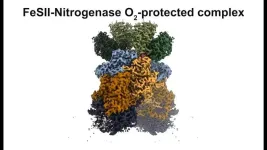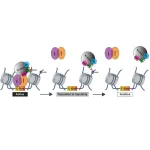(Press-News.org) Getting a good night’s sleep is a critical part of our daily biological cycle and is associated with improved brain function, a stronger immune system, and a healthier heart. Conversely, sleep disorders like insomnia and sleep apnea can significantly impact health and quality of life. Poor sleep often precedes the onset of neurodegenerative diseases and is a predictor of early dementia.
New research appearing in the journal Cell describes for the first time the tightly synchronized oscillations in the neurotransmitter norepinephrine, cerebral blood, and cerebrospinal fluid (CSF) that combine during non-rapid eye movement (non-REM) sleep in mice. These oscillations power the glymphatic system—a brain-wide network responsible for removing protein waste, including amyloid and tau, associated with neurodegenerative diseases.
“As the brain transitions from wakefulness to sleep, processing of external information diminishes while processes such as glymphatic removal of waste products are activated,” said Maiken Nedergaard, MD, DMSc, co-director of the University of Rochester Center for Translational Neuromedicine and lead author of the study. “The motivation for this research was to better understand what drives glymphatic flow during sleep, and the insights from this study have broad implications for understanding the components of restorative sleep.”
The study also holds a warning for people who use the commonly prescribed sleep aid zolpidem. The drug suppressed the glymphatic system, potentially setting the stage for neurological disorders like Alzheimer’s, which are the result of the toxic accumulation of proteins in the brain.
The “missing link” in the glymphatic system
The research, conducted by a team at the University of Rochester and the University of Copenhagen, employed an optic technique called flow fiber photometry combined with electroencephalogram and electromyography monitors. Unlike previous research techniques, which immobilized the mice and used anesthesia to induce sleep, the new approach allowed researchers to record brain activity during long, uninterrupted periods of wakefulness and sleep while allowing mice to move freely during recordings.
The research highlights the critical role of norepinephrine, a neurotransmitter associated with arousal, attention, and the body's response to stress. The team observed that slow synchronized waves of norepinephrine, cerebral blood volume, and CSF flow characterized non-REM sleep. The norepinephrine triggered “micro-arousals,” causing vasomotion, the rhythmic constriction of blood vessels independent of the heartbeat. This oscillation, in turn, generates the pumping action necessary to move CSF in the glymphatic system during sleep.
“These findings, combined with what we know about the glymphatic system, paint the whole picture of the dynamics inside the brain, and these slow waves, micro-arousals, and the norepinephrine were the missing link,” said Natalie Hauglund, PhD, first author of the study and currently a postdoctoral fellow at the University of Oxford.
The hidden risks of sleep aids
The study also explored whether sleep aids replicate the natural oscillations necessary for glymphatic function. The team focused on zolpidem, a sedative marketed under the name Ambien, which is frequently prescribed to treat insomnia.
While zolpidem effectively induced sleep in the mice, it also suppressed norepinephrine oscillations, disrupting the glymphatic system and impeding the brain’s waste-clearing processes, a finding that raises concerns about its long-term use.
Scientists now have a new tool and potential target to improve sleep. “The research provides a mechanistic link between norepinephrine dynamics, vascular activity, and glymphatic clearance, advancing understanding of sleep’s restorative functions,” said Nedergaard. “It also calls attention to the potentially detrimental effects of certain pharmacological sleep aids on brain health, highlighting the necessity of preserving natural sleep architecture for optimal brain function.”
Additional co-authors include Mie Andersen, Klaudia Torkarska, Tessa Radivanovic, Celia Kjaerby, Frederikke Sorensen, Zuzanna Bojarowska, Verena Untiet, Sheyla Ballestero, Mie Kolmos, Pia Weikop, and Hajime Hirase with the University of Copenhagen. The research was supported with funding the Novo Nordisk Foundation, the National Institutes of Health, the US Army Research Office, the Human Frontier Science Program, the Dr. Miriam and Sheldon G. Adelson Medical Research Foundation, the Simons Foundation, and the Cure Alzheimer Fund.
END
Common sleep aid may leave behind a dirty brain
2025-01-08
ELSE PRESS RELEASES FROM THIS DATE:
Plant cells gain immune capabilities when it’s time to fight disease
2025-01-08
LA JOLLA (January 8, 2025)—Human bodies defend themselves using a diverse population of immune cells that circulate from one organ to another, responding to everything from cuts to colds to cancer. But plants don’t have this luxury. Because plant cells are immobile, each individual cell is forced to manage its own immunity in addition to its many other responsibilities, like turning sunlight into energy or using that energy to grow. How these multitasking cells accomplish it all—detecting threats, communicating those threats, and ...
Study sheds light on depression in community-dwelling older adults
2025-01-08
January 8, 2025—Marked variation in the prevalence of depression was found in a multisite sample of community-dwelling older adults in the United States reports a study by Columbia University Mailman School of Public Health. Until now, few studies, have examined the frequency of depression in community-dwelling older adults in the U.S. The study is published in the Journal of American Geriatrics Society.
Of the 2,900 participants studied, 6.2 percent had depression. Older adults who had a negative history of depression or had annual household incomes of $50,000 or greater were at significantly decreased ...
Discovery of new class of particles could take quantum mechanics one step further
2025-01-08
PROVIDENCE, R.I. [Brown University] — Amid the many mysteries of quantum physics, subatomic particles don’t always follow the rules of the physical world. They can exist in two places at once, pass through solid barriers and even communicate across vast distances instantaneously. These behaviors may seem impossible, but in the quantum realm, scientists are exploring an array properties once thought impossible.
In a new study, physicists at Brown University have now observed a novel class of quantum particles called fractional excitons, which behave in unexpected ways and could significantly ...
Cost-effectiveness of a polypill for cardiovascular disease prevention in an underserved population
2025-01-08
About The Study: The results of this economic evaluation suggest that cardiovascular polypill treatment (single pill containing a statin and 3 half-standard dose antihypertensives) could be a high value intervention for a low-income, majority Black population with limited access to health care services. It could additionally reduce health disparities.
Corresponding Author: To contact the corresponding author, Ciaran N. Kohli-Lynch, PhD, email ciaran.kohli-lynch@northwestern.edu.
To access the embargoed study: Visit our For The Media ...
Development and validation of a tool to predict onset of mild cognitive impairment and Alzheimer dementia
2025-01-08
About The Study: In this prognostic study, with the use of a statistical modeling approach, the Florey Dementia Index was developed and validated to predict the onset age of mild cognitive impairment and Alzheimer dementia. This tool may be useful in organizing health care for older adults with cognitive decline or dementia and in the future may help prioritize patients for the use of disease-modifying monoclonal antibody drugs.
Corresponding Authors: To contact the corresponding authors, email Yijun Pan, PhD (yijun.pan@unimelb.edu.au) ...
New AI predicts inner workings of cells
2025-01-08
NEW YORK, NY (Jan. 8, 2025)--Using a new artificial intelligence method, researchers at Columbia University Vagelos College of Physicians and Surgeons can accurately predict the activity of genes within any human cell, essentially revealing the cell’s inner mechanisms. The system, described in the current issue of Nature, could transform the way scientists work to understand everything from cancer to genetic diseases.
“Predictive generalizable computational models allow to uncover biological ...
Scientists uncover key step in how diazotrophs “fix” nitrogen
2025-01-08
Nitrogen is an essential component in the production of amino acids and nucleic acids — both necessary for cell growth and function. Although the atmosphere is composed of nearly 80% nitrogen, this nitrogen is in the form of dinitrogen (N2), which cannot be processed by most organisms. Atmospheric nitrogen must first be converted, or “fixed,” into a form that can be used by plants, often as ammonia.
There are only two ways of fixing nitrogen, one industrial and one biological. To better understand a key component of the biological process, University of California San Diego Professor of Chemistry and Biochemistry Akif Tezcan and Assistant Professor of Chemistry ...
The hidden mechanics of earthquake ignition
2025-01-08
A new study has unravelled the hidden mechanics of how earthquakes ignite, shedding light on the mysterious transition from quiet, creeping motion to the violent ruptures that shake the Earth. Using cutting-edge experiments and innovative models, the research reveals that slow, silent stress release is a prelude and a necessary trigger for seismic activity. By incorporating the overlooked role of fault geometry, the study challenges long-held beliefs and offers a fresh perspective on how and when earthquakes begin. These findings not only deepen our understanding of nature’s ...
Scientists leverage artificial intelligence to fast-track methane mitigation strategies in animal agriculture
2025-01-08
BUSHLAND, Texas, Jan. 8, 2025 –A new study from USDA’s Agricultural Research Service (ARS) and Iowa State University (ISU) reveals that generative Artificial Intelligence (AI) can help expedite the search for solutions to reduce enteric methane emissions caused by cows in animal agriculture, which accounts for about 33 percent of U.S. agriculture and 3 percent of total U.S. greenhouse gas emissions.
"Developing solutions to address methane emissions from animal agriculture is a critical priority. Our scientists continue to use innovative and data-driven strategies to help ...
Researchers unravel a novel mechanism regulating gene expression in the brain that could guide solutions to circadian and other disorders
2025-01-08
A collaborative effort between Mount Sinai and Memorial Sloan Kettering Cancer Center has shed valuable light on how monoamine neurotransmitters such as serotonin, dopamine, and now histamine help regulate brain physiology and behavior through chemical bonding of these monoamines to histone proteins, the core DNA-packaging proteins of our cells.
By uncovering how these histone modifications influence the brain, the team has identified a novel mechanism for controlling circadian gene expression and behavioral rhythms. ...


